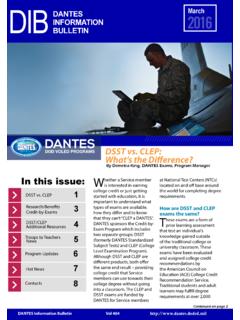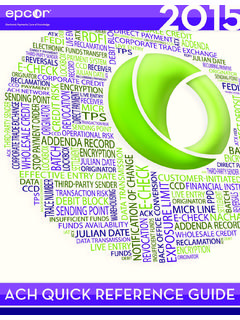Transcription of Module Specification: Mastering Metrics - SLIM
1 Module specification : Mastering Metrics Page 1 of 21 CIM October 2014 Module specification : Mastering Metrics Mastering Metrics is a 15-credit mandatory Module which sits within the suite of Level 6 modules. To gain the CIM Level 6 Diploma in Professional Marketing a pass in both mandatory modules plus one elective Module is required. However, each Module can be taken as a standalone Module to gain a Module award. Aim of the Module This Module examines the importance of managing marketing data in effective marketing decision making. It presents the role of marketing Metrics within the organisation and establishes how an understanding of a range of measurement techniques can enable organisations to achieve marketing insights and strategic decision making. It provides an appreciation of how measurement techniques, aligned to business objectives, can establish and determine the effectiveness of marketing activities.
2 It outlines the value of using appropriate data sources to enable effective marketing analysis, and of employing appropriate analytics tools and techniques to ensure effective marketing decision making. Module structure The Module comprises three units of two learning outcomes each. Each learning outcome will be covered by the related assessment criteria and will be assessed by way of assignment. The assessment will require submission of a 12-page assignment based on a given scenario and an organisation of choice. The assignment is broken down into three tasks. The learning outcomes and assessment criteria, along with the indicative content, are detailed in the Mastering Metrics Module content which follows. Module specification : Mastering Metrics Page 2 of 21 CIM October 2014 CIM Level 6 Diploma in Professional Marketing Qualification specification Please refer to the CIM Level 6 Diploma in Professional Marketing Qualification specification for all other information relating to the CIM Level 6 Diploma in Professional Marketing including: CIM Professional Marketing Standards The Level 6 qualification structure Who it s for Entry requirements The Modular Pathway Progression Credits and learning hours Modes of study How it s assessed assessment methodology How the assessment is delivered and when How it s graded When are results issued?
3 Module specifications What we mean by command words Suggested reading and resources Transition arrangements Module specification : Mastering Metrics Page 3 of 21 CIM October 2014 Module Content: Mastering Metrics (mandatory) Level 6 Credit value: 15 Notional learning time: 130-150 hours Purpose statement Marketers are faced with an increasing volume and range of marketing data, innovative methods of analysis and new measures of marketing effectiveness. This Module will equip you with the ability to selectively analyse different sets of marketing data for insight, and to undertake effective decision making in relation to the utilisation of marketing resources. Assessment Module weighting Work-based assignment LO 1 weighting 15% LO 2 weighting 10% LO 3 weighting 15% LO 4 weighting 20% LO 5 weighting 15% LO 6 weighting 25% Overarching learning outcomes By the end of this Module students should be able to: Metrics and analytics Understand the role of marketing Metrics Understand the significance of different measurement techniques across a range of market contexts Measuring effectiveness Know the relevant measures of marketing performance Apply marketing Metrics to establish the effectiveness of marketing activities Analytics for decision making Understand appropriate sources of data for marketing analysis Utilise various analytics tools and techniques for marketing insight and strategic decision making Module specification : Mastering Metrics Page 4 of 21 CIM October 2014 Unit 1.
4 Metrics and Analytics Learning outcomes The learner will: Assessment criteria The learner can: Indicative content 1. Understand the role of marketing Metrics Identify the context and requirements for an organisation to be able to set effective marketing Metrics The alignment of business objectives, strategies and Metrics The potential gap between Metrics and business outcomes People, planet and profit The importance of marketing Metrics Measuring marketing effectiveness Long-term assets and short-term financials Analyse the working practices and processes that allow Metrics to be implemented and used in an iterative manner Effective team structures Workflow management Reporting techniques Marketing and sales alignment Key marketing metric models Analytics vs. Metrics Understand the risk of poorly implemented Metrics and communicate examples of this in practice The dangers of measuring the wrong factors Business failure due to incorrect measurement and Metrics The risks of relying on single sources of Metrics Margins of error, reliability and service-level agreements within Metrics tools Understand the major areas of marketing Metrics Market and brand Metrics Customer profiling, satisfaction Module specification : Mastering Metrics Page 5 of 21 CIM October 2014 and loyalty Metrics Channel and distribution Metrics Margins, profits and profitability Metrics Sales funnel Metrics Product and portfolio Metrics Pricing Metrics Promotional and media Metrics Digital Metrics Business, finance and marketing Metrics 2.
5 Understand the significance of different measurement techniques across a range of market contexts Identify the different types of measurement techniques that may be needed in the different phases of an organisation s life Start-up, development and maturity challenges Measuring for stakeholders Business-value Metrics (owners, shareholders, employees, government, trustees) Strategic Metrics Operational Metrics Activity Metrics Outcome-based Metrics Leading indicators Predictive Metrics Outline and analyse Metrics associated with brand, margins, profits, sales and business results Metrics and brand management Margins and profits Lifetime value Sales force and sales funnel Metrics Portfolio management Return on investment Outline and analyse Metrics associated with customers, products, pricing and channels Customers, retention, recency and lifetime value Profiling Metrics using geo-demographics such as ACORN, Module specification : Mastering Metrics Page 6 of 21 CIM October 2014 MOSAIC Customer-service Metrics Products, stock and inventory management Metrics on pricing strategy and tactics Communication and web Metrics Digital Metrics Different Metrics for different organisational contexts.
6 B2C, B2B, NFP/3rd sector, SMEs, producers, distributors, retail, online Module specification : Mastering Metrics Page 7 of 21 CIM October 2014 Unit 2: Measuring Effectiveness Learning outcomes The learner will: Assessment criteria The learner can: Indicative content 3. Know the relevant measures of marketing performance Evaluate the different types of marketing Metrics and how they can be applied to help inform business strategy and measure performance against strategy Business goals, strategy, marketing Metrics and the gaps between them Connecting channel Metrics to financial outcomes Strategic Metrics : planning components Operational Metrics : mix variables Tactical Metrics : activities and timings Market and brand penetration Awareness Metrics vs. action-based Metrics Return on investment Return on marketing investment Identify relevant measures, and analyse and communicate suggested responses to improve marketing performance Analytics analysis Integrating data sources including big data sets Using and developing balanced/marketing scorecard The challenge of having too much data Management reporting Create, justify and communicate Metrics -based dashboards that can improve marketing performance Dashboarding tools Pre- and post-deployment dashboard testing Financial dashboards Brand and market dashboards Module specification : Mastering Metrics Page 8 of 21 CIM October 2014 Product and pricing dashboards Sales funnel dashboards Channels and media dashboards Integrating multiple Metrics into holistic dashboards such as balanced scorecard dashboard 4.
7 Apply marketing Metrics to establish the effectiveness of marketing activities Understand how different types of marketing Metrics can be applied to help inform business tactical activity in an iterative manner Building an iterative process Defining the feedback loop Creating a test and learn environment Assess effectiveness Plan, analyse and modify marketing activities based on Metrics analysis Tracking trends Statistical significance Modelling and forecasting Testing and analysis Supporting changes in the planning and implementation Plan and analyse automated techniques for reacting to Metrics Setting dashboard trigger levels Monitoring and management responsibilities Scenario planning and planned reactions Attribution modelling Marketing automation Module specification : Mastering Metrics Page 9 of 21 CIM October 2014 Unit 3: Analytics for Decision Making Learning outcomes The learner will: Assessment criteria The learner can: Indicative content 5.
8 Understand appropriate sources of data for marketing analysis Demonstrate knowledge of a range of different sources of data for marketing analysis along with identification of their best use, strengths and limitations Strategic data sources Operational data sources Activity data sources Outcome data sources Predictive data sources Recommend a combination of different sources, including both online and offline data sources, which can work in combination to help with marketing analysis Online/offline integration Brand research Sales funnel data Sales and marketing integration Primary and secondary research Integrating channel data Dashboards Analytics analysis Demonstrate knowledge of how different types of Metrics can impact one another Product and pricing Metrics and their impact Brand Metrics and their impact Channel Metrics and profitability Promotional and media Metrics Service and satisfaction Metrics Financial and operational Metrics Building metric hierarchies and tracking interactions 6.
9 Utilise various analytics tools and techniques for marketing insight and strategic decision making Recommend the most appropriate and effective Metrics approach for a range of types of organisation and situations Business to consumer (B2C) Business to business (B2B) Not for profit Government Start-up Central issues for measurement in context Analysis of Metrics and relevance Module specification : Mastering Metrics Page 10 of 21 CIM October 2014 Measurement and accountability Evaluate the strengths and weaknesses of metric analysis and how it can impact strategic decision making Benefits and limitations of Metrics Analysing different data sources Advantages and disadvantages of real-time data Challenges presented by limited data analysis Statistical analysis Reliance on dashboards Understand the latest trends in Metrics and communicate their potential impact Real-time data analysis Tracking social media sentiment to adjust pricing, availability and brand positioning Free and low-cost dashboard tools Technology and platform integration Traditional and digital metric integration Module specification .
10 Mastering Metrics Page 11 of 21 CIM October 2014 Sample assessment material The following sample assessment material for Mastering Metrics has been produced to provide a true reflection of the live assessments and should be used as a guide and study aid when preparing for the live assessment. Module specification : Mastering Metrics Page 12 of 21 CIM October 2014 CIM Level 6 Diploma in Professional Marketing Mastering Metrics Sample assessment Assignment The assignment comprises THREE compulsory tasks. Task 1 is worth 20 marks. Task 2 is worth 35 marks. Task 3 is worth 35 marks. 10 marks are available for presentation of information. Total marks available 100. Candidate guidance: Answer all tasks The available marks are shown alongside each part of the task 10 marks are available for overall format and presentation of information Read all tasks carefully before attempting them Module specification : Mastering Metrics Page 13 of 21 CIM October 2014 Scenario: Market changes, resulting from confidence returning to the global economy, are opening up a range of opportunities within and across markets for the private, public and not-for-profit sectors.



